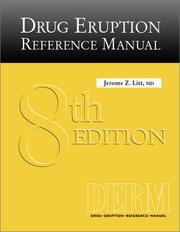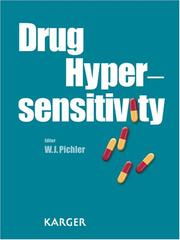| Listing 1 - 10 of 20 | << page >> |
Sort by
|
Book
Abstract | Keywords | Export | Availability | Bookmark
 Loading...
Loading...Choose an application
- Reference Manager
- EndNote
- RefWorks (Direct export to RefWorks)

ISBN: 1842141783 Year: 2002 Publisher: New York : Parthenon Publishing Group,
Abstract | Keywords | Export | Availability | Bookmark
 Loading...
Loading...Choose an application
- Reference Manager
- EndNote
- RefWorks (Direct export to RefWorks)
Book
Year: 2014 Publisher: Bruxelles: UCL. Faculté de médecine et de médecine dentaire,
Abstract | Keywords | Export | Availability | Bookmark
 Loading...
Loading...Choose an application
- Reference Manager
- EndNote
- RefWorks (Direct export to RefWorks)
The syndrom of drug reaction with eosinophila and systemic symptoms (DRESS syndrom) is a severe toxidermia caused by the taking of certain medication. More and more stud ies suggest a direct relationship between the apparition of a DRESS syndrom and the reactivation of certain herpesviruses. Hu man Herpesvirus 6 (HHV-6) seems to be mainly involved. And yet, the precise etiopathogeny of DRESS syndrom and the role played by HHV-6 remam unclear. Methods: We performed a prospective longitudinal case-control study with an etiological aim. The main goal of the study is to confirm whether herpesviruses are involved in DRESS syndrom . The secondary aim is to determine whether the search for those viral reactivations and alteration of immune cell s in doubtful DRESS syndrom is relevant. To perform the study, we recruited subjects using the diagnostical criteria settled by the European research group RegiSCAR. Results: Within two years, 4 patients developed a toxidermia compatible with a DRESS syndrom. One of them passed away and could therefore not be included in the study. The second refused to take part to the study. The diagnosis of DRESS syndrom could not be confirmed for the third patient. Therefore only one subject could be included up to now in our study. Th is patient developed a relapse of DRESS syndrom caused by allopurinol, 5 years after a first episode. In this subject, an early reactivation of EBV and later reactivation of CMV and HHV-6 were discovered. We compared these results with a patient with a benign drug-related rash caracterized as a delayed maculopapular rash caused by amoxici llin-clavulanic acid in which no viral reactivation was found. Discussion and Conclusion DRESS syndrom is extremely rare (10 cases per million patients per year) and hence, a two yea rs lasting study was not enough to collect a significant sample of patients. As a consequence, no conclusion can be drawn from this study. However, our results are in agreement with the actual data of the medical literature. As a conclusion, we think that this study must be carried on and could be a model for other studies aiming to improve the diagnosis of DRESS syndrom . Le syndrome de réaction médicamenteuse avec une éosinophilie et des symptômes systémiques (DRESS) est une toxidermie sévère due à la prise de certains médicaments. De plus en plus de publications suggèrent qu'il existe un lien direct entre le développement d'un syndrome DRESS et la réactivation de certains herpèsvirus. Le virus qui est le plus souvent mis en cause est l'herpèsvirus humain de type 6 (HHV-6). L'étiopathogénie exacte du DRESS et l 'implication de HHV-6 restent pourtant incertains. Matériel et Méthode: Nous avons réalisé une étude cas-témoins prospective à visée étiologique. Le but principal de l 'étude est de confirmer l 'implication des herpèsvirus dans le syndrome DRESS. L'objectif secondaire est d'évaluer l'intérêt de la recherche de ces réactivations virales et des altérations des cellules de l'immunité dans les cas de syndromes DRESS douteux. Pour réaliser cette étude, nous avons recruté les sujets en utilisant les mêmes critères diagnostiques que le groupe d'étude européen RegiSCAR. Résultats :En 2 ans, 4 patients ont présenté une toxidermie compatible avec un syndrome DRESS. L'und'entre eux est décédé et n 'a donc pas pu être inclus dans l 'étude. Le deuxième a refusé de participer à l'étude. Le d iagnostic de DRESS n'ayant pu être confirmé pour le troisième, seul un patient a pu être inclus jusqu'à présent. Ce patient présentait une récidive de syndrome DRESS à l 'allopurinol, 5 ans après un premier épisode. Celu i-ci a présenté une réactivation précoce du virus d'Epstein -Barr et la réactivation tardive de H HV-6 et du cytomégalovirus. Ces résultats ont été com parés à ceux d'un patient présentant une éruption médicamen teuse bénigne à type d'exanthème macu lopapuleux retardé à l'amoxicilline-clav ulanate et chez lequel aucun virus ne s'est réactivé .Discussion et Conclusion.Le syndrome DRESS étant extrêmement rare (10 syndromes DRESS / millions de personnes et par an), les 2 années d'étude n'ont pas été suffisantes pour obtenir un échantillon significatif de patients. Ceci ne nous permet donc pas de tirer de conclusion. Cependant, nos résultats concordent avec les données de la littérature. Dès lors, nous pensons que cette étude doit être poursuivie et pourrait servir de modèle à d'autres études destinées à améliorer le diagnostic de DRESS syndrome.
Book
ISBN: 2742005803 9782742005802 Year: 2005 Publisher: Montrouge: John Libbey eurotext,
Abstract | Keywords | Export | Availability | Bookmark
 Loading...
Loading...Choose an application
- Reference Manager
- EndNote
- RefWorks (Direct export to RefWorks)
Book
Year: 1973 Publisher: Springfield (Ill.): Thomas
Abstract | Keywords | Export | Availability | Bookmark
 Loading...
Loading...Choose an application
- Reference Manager
- EndNote
- RefWorks (Direct export to RefWorks)

ISBN: 9783805582698 3805582692 1435634047 3318014540 Year: 2007 Publisher: S. Karger
Abstract | Keywords | Export | Availability | Bookmark
 Loading...
Loading...Choose an application
- Reference Manager
- EndNote
- RefWorks (Direct export to RefWorks)
Drug allergy --- Drug Hypersensitivity --- Drug allergy. --- Drug Hypersensitivity.
Book
Year: 2012 Publisher: Bruxelles: UCL,
Abstract | Keywords | Export | Availability | Bookmark
 Loading...
Loading...Choose an application
- Reference Manager
- EndNote
- RefWorks (Direct export to RefWorks)
Photosensitivity Disorders --- Drug Hypersensitivity --- Pharmacists
Book
ISBN: 3540123997 3642690904 3642690882 Year: 1983 Publisher: Berlin Springer
Abstract | Keywords | Export | Availability | Bookmark
 Loading...
Loading...Choose an application
- Reference Manager
- EndNote
- RefWorks (Direct export to RefWorks)
Drug Hypersensitivity. --- Drug Allergy --- Allergy, Drug --- Hypersensitivity, Drug --- Allergies, Drug --- Drug Allergies --- Drug Hypersensitivities --- Hypersensitivities, Drug --- Hypersensitivity --- Drug Hypersensitivity Syndrome --- chemically induced --- DRUG HYPERSENSITIVITY --- Drug hypersensitivity --- Drug Hypersensitivity
Book
Year: 2011 Publisher: Bruxelles: UCL,
Abstract | Keywords | Export | Availability | Bookmark
 Loading...
Loading...Choose an application
- Reference Manager
- EndNote
- RefWorks (Direct export to RefWorks)
Antibiotic allergy and more generally drug allergy, results from interaction between a pharmacological agent (here, the antibiotic) and the human immune system. It may occur in the form of immediate or delayed hypersensitivity reaction. Immediate reaction is usually antibody IgE-mediated, whereas non immediate hypersensitivity reaction is usually T-cell mediated Any organ may be affected by the reaction, but the skin is most commonly involved, The diagnosis is based, first of all, on the identification of the putative antibiotic from a detailed and accurate drug history, complemented by validated allergological tests If it’s not sufficient, challenge test will be carried out Although allergic reactions to antibiotics represents only a small proportion of reported adverse drug reactions, they are associated with substantial morbidity, mortality and increased health costs. Data on incidence and prevalence of these reactions are available, but they should be interpreted with caution, because of the lack of precise and reliable studies The three major risk factors for these reactions include the chemical structure of the antibiotic, genetic and environmental factors. The treatment is largely supportive and includes discontinuation of the offending antibiotic, administration of antibiotic from an other category, symptomatic treatment and patient education. When no other curative treatment is available, the physician requires the desensitisation drug procedure. The pharmacist is generally the first one to be consulted to obtain medical advice, and therefore it is important to give him practical tools L’allergie aux antibiotiques et plus largement aux médicaments, provient de l’interaction entre un agent pharmacologique (ici, l’antibiotique) et le système immunitaire humain Elle peut se manifester sous forme de réaction d’hypersensibilité immédiate ou retardée La réaction immédiate fait intervenir les anticorps IgE, tandis que la réaction retardée fait appel aux lymphocytes T. Tous les organes peuvent être concernes par cette réaction, mais la peau demeure celui qui est le plus fréquemment touché. Le diagnostic est base avant tout sur l’identification de l’antibiotique suspect, grâce a l’histoire médicamenteuse précise du patient ainsi que les tests allergiques valides Si cela est insuffisant, alors le test de provocation sera réalisé. Bien que les réactions allergiques aux antibiotiques ne représentent qu’une petite proportion des effets secondaires des médicaments, elles sont cependant associées à une morbidité et mortalité importantes et à une augmentation des coûts de soins de santé. Les données concernant l’incidence et la prévalence de ces réactions sont disponibles mais doivent toutefois être interprétées avec prudence étant donné le manque d’études précises et valides. Les trois plus grands facteurs de risques de ces réactions sont la structure chimique de l’antibiotique, les facteurs génétiques et environnementaux. Le traitement comprend l’arrêt de l’antibiotique, l’instauration d’un traitement antibiotique d’une autre classe, un traitement symptomatique ainsi que l’éducation du patient concernant son allergie. S’il n’existe aucun autre antibiotique disponible, le médecin aura alors recours à la procédure de désensibilisation à l’antibiotique concerné. Le pharmacien est généralement le premier à être consulté en vue d’obtenir des conseils, et c’est pour cela qu’il est important de lui donner des outils pratiques
Drug Hypersensitivity --- Hypersensitivity --- Desensitization, Immunologic --- Pharmacists
Book
ISBN: 9819944406 Year: 2023 Publisher: Singapore : Springer Nature Singapore : Imprint: Springer,
Abstract | Keywords | Export | Availability | Bookmark
 Loading...
Loading...Choose an application
- Reference Manager
- EndNote
- RefWorks (Direct export to RefWorks)
This textbook assembles the wealth of clinical experiences across multiple medical specialties and offers clinical pearls that will result in better patient care and are highly relevant to daily practice. This book has been compiled by many renowned clinicians, medical educators, and researchers who are experts in their respective disciplines across Australia, New Zealand and the United States. The chapters provide multiple cases in vignette format, illustrating the clinical pearls, and finish with a discussion and practical tips. This format will allow the reader to easily understand how the clinical pearls can be applied in clinical practice. Evidence-based medicine and clinical guidelines help us choose the best management and treatment options for our patients. However, many questions in medicine have not been researched or are not readily amenable to research. In fact, there is more to the art and mastery of practicing clinical medicine than the evidence-based approach. Information gained over years of reflective clinical practice and cumulative wisdom adds value to evidence-based clinical medicine. With experience and clinical gestalt playing an equal, if not a more prominent role than what evidence can offer in a physician’s approach to solving clinical problems, this book offers unique perspectives on the practice of medicine. Beyond Evidence-Based Medicine: Clinical Pearls from Experienced Physicians will be valuable for later-year medical students, medical educators, doctors in training, and consultant physicians alike. Aiming to improve the day-to-day medical practices of professionals, the Editors have invited experienced physicians to share their expertise culminating in a unique book with broad applicability and appeal.
Medicine. --- Neurology. --- Gastroenterology. --- Cardiology. --- Allergy. --- Palliative treatment. --- Clinical Medicine. --- Allergology. --- Palliative Care. --- Medical Oncology. --- Evidence-Based Medicine. --- Drug Hypersensitivity.
| Listing 1 - 10 of 20 | << page >> |
Sort by
|

 Search
Search Feedback
Feedback About UniCat
About UniCat  Help
Help News
News